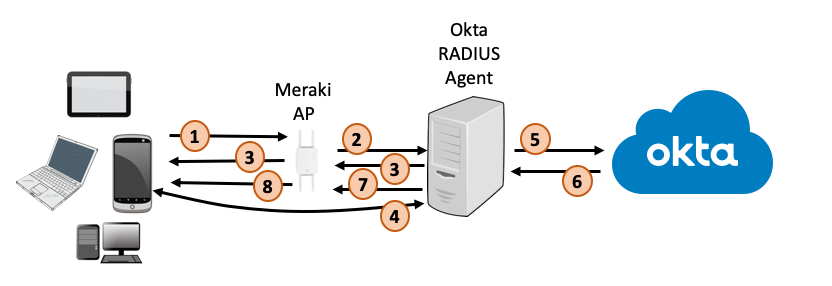Modern businesses are moving away from outdated Wi-Fi security models. Pre-shared keys (PSK) and certificate-based access have long served as default methods, but they no longer align with today’s distributed workforces and flexible network environments. The rise of remote work, hybrid office setups, and the bring-your-own-device (BYOD) model has amplified the demand for smarter, more adaptive wireless access controls.
Identity-first Wi-Fi authentication has emerged as a reliable answer. This approach places user identity at the core of every access request. Instead of trusting a device simply because it knows a password, networks now verify who the user is before granting access. The integration of Cisco Meraki and Okta brings this concept to life with a seamless, secure, and scalable solution. Together, Meraki Okta give businesses a centralized and user-friendly way to protect their wireless infrastructure.
Most organizations still rely on WPA2-PSK for Wi-Fi access. While convenient, PSKs are vulnerable to password sharing, brute-force attacks, and insider misuse. Rotating passwords is time-consuming and often ignored, creating long-term security risks. Once a device is connected, there’s little visibility into who’s behind the screen.
Certificate-based solutions such as EAP-TLS offer stronger security but are complex to manage. IT teams must deploy, track, and revoke certificates across a mix of devices. This approach often demands additional infrastructure, such as internal PKI systems, and leaves gaps when users bring personal devices into the mix. These limitations expose a clear need for a more flexible, identity-centric model.
Okta serves as a cloud-based identity provider (IdP) that centralizes authentication for users, apps, and devices. Instead of managing credentials in multiple places, Okta brings everything under one umbrella. It supports a wide range of authentication methods and integrates with many business systems.
Okta’s Single Sign-On (SSO) reduces friction by allowing users to authenticate once and gain access to multiple services. Adaptive Multi-Factor Authentication (MFA) adds another layer of protection by analyzing login context, such as location, device, or behavior, before allowing access. This dynamic approach fits perfectly into an identity-first Wi-Fi strategy. Lifecycle management ensures that user access changes in real time based on employment status or group membership, which is especially important in large or dynamic organizations.
When paired with Wi-Fi authentication, these capabilities ensure only verified users with appropriate roles can connect. It makes the wireless network smarter, able to evaluate who’s connecting and how, before assigning access rights.
Cisco Meraki provides powerful cloud-managed wireless access points that simplify network operations without compromising visibility or control. With an intuitive dashboard and scalable architecture, Meraki makes it easier to enforce policies, monitor activity, and adjust settings in real time across all locations.
The Meraki dashboard offers a single pane of glass to control Wi-Fi, switching, and security. This includes SSID-level policies, VLAN segmentation, traffic shaping, and device authentication. When configured for external RADIUS or SAML-based authentication, Meraki can work directly with identity providers like Okta. This means organizations can link their existing identity systems to their network infrastructure without adding more hardware or middleware.
The Meraki platform also supports role-based access, policy-driven VLAN assignment, and dynamic group-level restrictions, which are critical features for enforcing least-privilege access.

When appropriately configured, Meraki and Okta create a tight feedback loop between user identity and network access. Meraki wireless networks can be set up to authenticate users via RADIUS or SAML, pointing to Okta as the authoritative source of identity.
Here’s how it works: When a user attempts to connect to a Meraki SSID, the request is routed to Okta via a cloud-hosted RADIUS proxy such as JumpCloud, SecureW2, or Foxpass. Okta verifies the user credentials and checks for policies such as MFA enforcement or group membership. Only after the identity has been validated does the user gain access to the network.
Protocols like SAML and RADIUS enable this secure handshake between Meraki and Okta. Meraki’s RADIUS authentication supports dynamic VLAN assignment and policy enforcement, which lets IT teams tailor access based on user role or department. This setup also enables device posture checks, meaning only devices that meet compliance standards (e.g., up-to-date antivirus or MDM enrollment) can connect.
This integrated approach removes the risks of shared passwords and replaces them with granular control over who gets access, when, and from which devices.
Improved Security
By linking Wi-Fi access to verified user identity, businesses eliminate the need for shared credentials. Okta ensures that only valid users pass through the authentication gate, and Meraki ensures that those users are segmented and monitored appropriately. MFA further hardens the connection, adding context-aware protection against credential theft.
Enhanced User Experience
From the user’s perspective, there’s less hassle. Employees log in with their regular Okta credentials, with no separate Wi-Fi passwords or certificates to manage. Okta’s SSO ensures smooth access to cloud services after authentication, making network entry feel like part of the broader digital workplace experience.
Operational Efficiency
IT administrators gain centralized control. Instead of managing device lists, password resets, or certificate deployments, they define access policies in Okta and push them through Meraki’s dashboard. Changes to user roles automatically affect Wi-Fi access, streamlining onboarding, offboarding, and compliance audits.
For a successful Meraki-Okta deployment, preparation is key.
Start by ensuring your Okta directory is properly synced with your internal user base. This includes confirming group structures, user attributes, and MFA policies. If you plan to use a RADIUS proxy, set up the integration ahead of time and test with a small group of users.
Next, configure Meraki SSIDs for enterprise authentication. Define access policies based on groups or roles, and align VLAN settings accordingly. Make sure your RADIUS servers and dashboards are communicating securely.
Finally, test across different environments. Validate how the solution works in both on-site and remote scenarios, especially if your users rely on VPN or remote-access tools. Monitor authentication logs in both Meraki and Okta dashboards to troubleshoot edge cases and optimize user flows.
A phased rollout often works best. Start with a pilot team, gather feedback, and adjust policies before a full deployment.
The threat of compromised credentials and insecure access points is growing. Attackers increasingly target Wi-Fi networks as easy entry points, especially when weak authentication is in place. As devices and users move more fluidly across locations, static security models no longer suffice.
Meraki and Okta provide a practical way to align wireless security with Zero Trust principles. Every login is verified. Every device is accounted for. Every session is monitored. For organizations that value agility, visibility, and security, this is the next step forward.
Struggling to manage Wi-Fi access with shared passwords or outdated certificates? It may be time to adopt identity-first authentication.
Stratus Information Systems specializes in secure Meraki deployments that integrate seamlessly with Okta. From design to rollout, our Cisco-certified team can help your organization simplify its Wi-Fi security while increasing user satisfaction.
Contact Stratus Information Systems today to learn how to integrate Meraki with Okta for seamless, identity-first Wi-Fi authentication.

Continue Reading...